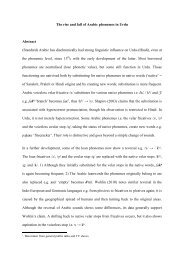Glottalization in the Gaelic of Gigha and Islay: a phonological sketch ...
Glottalization in the Gaelic of Gigha and Islay: a phonological sketch ...
Glottalization in the Gaelic of Gigha and Islay: a phonological sketch ...
You also want an ePaper? Increase the reach of your titles
YUMPU automatically turns print PDFs into web optimized ePapers that Google loves.
<strong>Glottalization</strong> <strong>in</strong> <strong>the</strong> <strong>Gaelic</strong> <strong>of</strong> <strong>Gigha</strong> <strong>and</strong> <strong>Islay</strong>: a <strong>phonological</strong> <strong>sketch</strong><br />
Anna Bosch,<br />
University <strong>of</strong> Kentucky<br />
(paper only)<br />
Despite <strong>the</strong> publication <strong>of</strong> <strong>the</strong> detailed phonetic transcriptions <strong>of</strong> <strong>the</strong> <strong>Gaelic</strong><br />
l<strong>in</strong>guistic survey (Survey <strong>of</strong> <strong>the</strong> <strong>Gaelic</strong> Dialects <strong>of</strong> Scotl<strong>and</strong>, Ó Dochartaigh 1994-97<br />
[SGDS]), <strong>Gaelic</strong> examples are rare <strong>in</strong> discussions <strong>of</strong> <strong>phonological</strong> <strong>the</strong>ory. This talk<br />
presents an a nalysis <strong>of</strong> a pervasive glottalization found <strong>in</strong> certa<strong>in</strong> dialects, a little -<br />
known phenomena occurr<strong>in</strong>g <strong>in</strong> <strong>the</strong> phonology <strong>of</strong> <strong>Gigha</strong> <strong>and</strong> <strong>Islay</strong>, although with<br />
slightly different systemic consequences <strong>in</strong> each variety. The focus <strong>of</strong> <strong>the</strong> talk will be<br />
two-fold, both descriptive <strong>and</strong> <strong>the</strong>oretical. The descriptive account will lay out <strong>the</strong><br />
facts <strong>of</strong> <strong>Gigha</strong> <strong>and</strong> <strong>Islay</strong> glottalization, as based on fieldwork by Hamp published <strong>in</strong><br />
SGDS, as well as unpublished archival data from <strong>the</strong> L<strong>in</strong>guistic Survey <strong>of</strong> Scotl<strong>and</strong>.<br />
The geographic distribution <strong>of</strong> this feature, based on published <strong>and</strong> unpublished<br />
sources, will also be del<strong>in</strong>eated. Questions addressed by <strong>the</strong> analysis will <strong>in</strong>clude <strong>the</strong><br />
follow<strong>in</strong>g:<br />
(a) Is glottalization here properly represented as a ‘feature’ or as a ‘segment’?<br />
(b) How does glottalization bear on a consistent representation <strong>of</strong> hiatus <strong>in</strong> <strong>the</strong> dialects<br />
under consideration?<br />
(c) How does glottalization affect <strong>the</strong> perception <strong>of</strong> svarabhakti words <strong>in</strong> <strong>the</strong>se speech<br />
varieties?<br />
Svarabhakti words demonstrate an epen<strong>the</strong>tic vowel between a nonhomorganic<br />
sonorant <strong>and</strong> a voiced obstruent; <strong>in</strong> western Hebridean dialects <strong>the</strong><br />
epen<strong>the</strong>tic vowel is usually some copy <strong>of</strong> <strong>the</strong> preced<strong>in</strong>g stressed vowel (Borgstrøm<br />
1937; Oftedal 1956). Oftedal <strong>and</strong> Borgstrom both po<strong>in</strong>t out a particular ris<strong>in</strong>g or level<br />
tone pattern <strong>in</strong> <strong>the</strong>se words, contrast<strong>in</strong>g with <strong>the</strong> regular fall<strong>in</strong>g pitch <strong>of</strong> ord<strong>in</strong>ary<br />
disyllabic words. The svarabhakti/non-svarabha kti contrast is one <strong>of</strong> <strong>the</strong> mostdiscussed,<br />
<strong>and</strong> yet little -understood, aspects <strong>of</strong> <strong>Gaelic</strong> phonology, with considerable<br />
literature on <strong>the</strong> <strong>phonological</strong> consequences <strong>of</strong> this particular type <strong>of</strong> epen<strong>the</strong>sis<br />
(Kenstowicz & Kisseberth 1979, Clements 1987, Bosch & de Jong 1997, 1998).<br />
Interest<strong>in</strong>gly, <strong>the</strong> dialects <strong>of</strong> <strong>Gigha</strong> <strong>and</strong> <strong>Islay</strong> do not share <strong>the</strong> prosodic or featural<br />
patterns <strong>of</strong> svarabhakti that <strong>the</strong> Hebridean dialects demonstrate; if we ignore <strong>the</strong><br />
glottalisation facts, it would appear that <strong>the</strong>se dialects <strong>of</strong> <strong>Gaelic</strong> do not dist<strong>in</strong>guish<br />
svarabhakti words at all. However, I argue that it is precisely <strong>the</strong> presence or absence<br />
<strong>of</strong> glottalization which now takes on this dist<strong>in</strong>guish<strong>in</strong>g role.<br />
In addition to present<strong>in</strong>g a prelim<strong>in</strong>ary analysis <strong>of</strong> one <strong>in</strong>trigu<strong>in</strong>g aspect <strong>of</strong><br />
<strong>Gaelic</strong> dialectology, I also hope to beg<strong>in</strong> a discussion on <strong>the</strong> role <strong>and</strong> usefulness <strong>of</strong><br />
large scale dialect surveys <strong>and</strong> archival materials for contemporary work <strong>in</strong><br />
<strong>phonological</strong> <strong>the</strong>ory.
Works Cited:<br />
Borgstrøm, C.H. 1937. The Dialect <strong>of</strong> Barra <strong>in</strong> <strong>the</strong> Outer Hebrides. Norstk Tidsskrift for<br />
Sprogvidenskap 8. Oslo: Aschehoug & co.<br />
Bosch, Anna & Kenneth de Jong. 1998. Syllables <strong>and</strong> supersyllables: Evidence for low<br />
level <strong>phonological</strong> doma<strong>in</strong>s. Texas L<strong>in</strong>guistic Forum 41:1-14.<br />
Bosch, Anna & Kenneth de Jong. 1997. The Prosody <strong>of</strong> Barra <strong>Gaelic</strong> Epen<strong>the</strong>tic<br />
Vowels. Studies <strong>in</strong> <strong>the</strong> L<strong>in</strong>guistic Sciences 27: 1-15.<br />
Clements, G.N. 1986. Syllabification <strong>and</strong> epen<strong>the</strong>sis <strong>in</strong> <strong>the</strong> Barra dialect <strong>of</strong> <strong>Gaelic</strong>. In:<br />
The Phonological Representation <strong>of</strong> Suprasegmentals, K. Bogers et al. (eds.).<br />
Dordrecht: Foris Publications.<br />
Kenstowicz, M. & Kisseberth, C. 1979. Generative Phonology. New York: Academic<br />
Press.<br />
Ó Dochartaigh, Cathair, ed. 1994-97. Survey <strong>of</strong> <strong>the</strong> <strong>Gaelic</strong> Dialects <strong>of</strong> Scotl<strong>and</strong>, 5<br />
vols. Dubl<strong>in</strong>: Dubl<strong>in</strong> Institute for Advanced Studies.<br />
Oftedal, Magne. 1956. The <strong>Gaelic</strong> <strong>of</strong> Leurbost, Isle <strong>of</strong> Lewis. Norsk Tidsskrift for<br />
Sprogvidenskap, suppl. b<strong>in</strong>d IV. Oslo: Aschehoug & co.
















